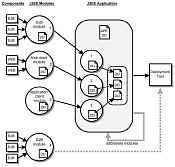Get the app out
Discover the ins and outs of J2EE application assembly and deployment We all built EJBs, servlets, and JSPs before J2EE came upon the scene at 1999’s JavaOne. In those days, EJBs were deployed into EJB containers (mostly in application servers…
Sun outlines J2EE strategy
J2EE gets glowing one-year report card; version 1.3 on the way San Francisco (January 16, 2001) — Sun Microsystems today outlined its J2EE strategy for the coming year, gave a glimpse of its Web services strategy, and detailed a new…
Thanks type and gentle class
Type and class are not interchangeable terms, but two carefully distinguishable object-oriented concepts In Shakespeare’s Hamlet, the king and queen of Denmark address two of Hamlet’s buddies with “Thanks Rosencratz and gentle Guildenstern” and “Thanks Guildenstern and gentle Rosencratz.” Critics…
FreeMarker: An open alternative to JSP
How the template-based, open source API FreeMarker trumps JSP FreeMarker, an alternative to JavaServer Pages, is a template-based, open source API that leverages the skills of Java developers and HTML authors in parallel. You can place FreeMarker tags in text…
A Java case study: The power of J2EE
How the Energy Information Administration secured a complete J2EE solution in less than five months The Energy Information Administration (EIA) collects data from the energy industry on nearly 80 survey instruments, managed by several program offices. In 1996, realizing all…
Java Product News (January 12, 2001)
ePath Learning unveils Learning ASAP 2.0 ePath Learning has introduced ePath Learning ASAP 2.0, an eLearning development tool that helps nonprogrammers create, distribute, and coordinate multimedia eLearning courses, performance support systems, and tests via the Internet. The application: Establishes links…
When is a singleton not a singleton?
Avoid multiple singleton instances by keeping these tips in mind The singleton is a useful design pattern for allowing only one instance of your class, but common mistakes can inadvertently allow more than one instance to be created. In this…
Retrofit existing applications with RMI
Minimize code changes and gain flexibility by using the Adapter pattern on the client side Most tutorials on Java’s Remote Method Invocation (RMI) technology use as examples new programs that were initially written to use RMI; that practice excludes those…
Design for performance, Part 1: Interfaces matter
Avoid performance hazards when designing Java classes Many programmers don’t start thinking about performance management until late in the development cycle. Often, they hold off on performance tuning until the end, hoping perhaps to avoid it entirely — and sometimes…
Construct secure networked applications with certificates, Part 1
Certificates add value to public-key cryptography I am thankful that the security issue has been pushed out of obscurity and into the spotlight during the last few years. Due to well-publicized threats and attacks, almost everyone, from the development staff…





